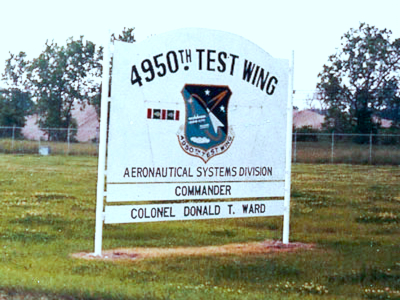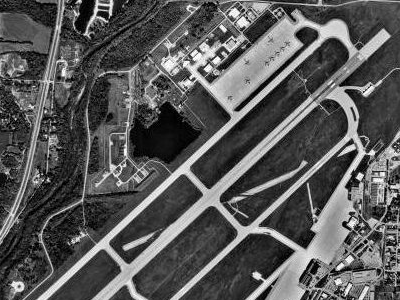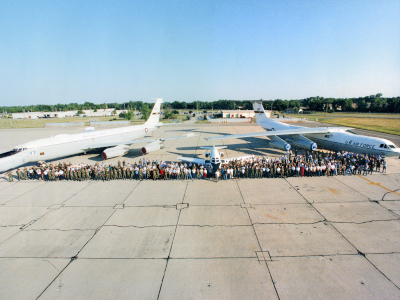


Wright-Patterson Air Force Base
In December 1975, after seven years of operation by Air Force Eastern Test Range, the ARIA, re-designated Advanced Range Instrumentation Aircraft following completion of the Apollo program, was transferred to the 4950th Test Wing at Wright-Patterson AFB, Ohio, as part of an Air Force consolidation of large test and evaluation aircraft. By the early 1980’s, the ARIA fleet consisted of eight modified aircraft, six EC-135N aircraft with J-57 turbojet engines and two EC-135B aircraft with TF-33 turbofan engines.
Dedicated to support of worldwide missile and space testing, the aircraft modifications included a 7 foot diameter telemetry antenna, housed in a ten foot radome in the nose of the aircraft. It also included extensive telemetry communications instrumentation which could be configured to perform telemetry tracking of dynamic objects, telemetry signal reception and recording, on board data processing and reformatting, real-time or post-mission (retransmission) data relay through communication satellites via high frequency radio or direct line-of-sight relay to ground stations, and voice communications relay. In addition to the antenna in the nose, the ARIA had a probe antenna on each wing tip as well as a trailing wire antenna on the bottom of the fuselage, all used for high frequency radio transmission and reception. Further external modifications included antennas for post-mission data retransmission and satellite communications. The internal modification to the cargo compartment included all of the instrumentation subsystems (Prime Mission Electronic Equipment) installed in the form of a 30,000 pound modular package. Modifications also included provisions for eight to nine additional crew members to operate the instrumentation equipment. The current Prime Mission Electronic Equipment was organized into six functional subsystems and a master control console to provide the ARIA mission support capability. The Antenna Subsystem acquired and tracked, either manually, automatically, or by computer, the launch vehicle using the 7 foot dish antenna mounted in the nose radome. The Telemetry Subsystem was configured as a set of six dual-channel AN/AKF-4 receivers that received the vehicle telemetry signals. The Record Subsystem was designed to use Inter-Range Instrumentation Group-standard equipment to meet user requirements for data recording, monitoring, and playback. The Timing Subsystem, physically collocated with the Record Subsystem, served as the central timing facility for the ARIA electronic suite, generating time codes to permit time correlation of vehicle events during tape processing. The Communications Subsystem provided the voice communications through three 1000 watt single sideband high frequency transmitters and receivers, and data transmission through a 1000 watt AN/ARC-l46 UHF satellite terminal. The Data Separation Subsystem further processed the telemetry signals, generally a combination of several channels of analog and/or digital information, into individual measurements for on board display. The last module, the Master Control Console was operated by the ARIA mission coordinator, to control on board management merit of the instrumentation crew.
Credit: United States Air Force